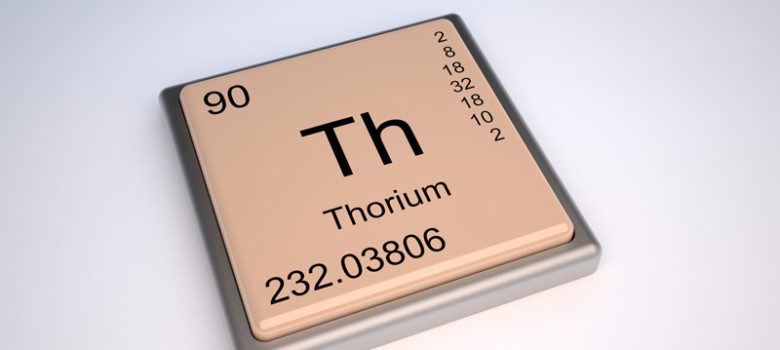
Introduction to Thorium nuclear power
The energy released from nuclear fission is approximately 1 million times greater than the energy released from chemical combustion from fossil fuels. Today we rely on Uranium 235 to provide us with our nuclear energy, however this only represents about 0.7% of the Uranium found on the planet (the majority being Uranium-238).
The difficulty is that the mined Uranium needs to be ‘enriched’ to contain a higher percentage of U-235 in order to sustain a nuclear reaction, which is a very costly and energy intensive process. The Uranium-235 is bombarded with neutrons which transmutes into plutonium-239, which is fissile, releasing an abundance of energy when it breaks down.
However there is another element that could be used as a nuclear energy source, known as Thorium.
Thorium was discovered in 1829 by the Swedish chemist Jons Jakob Berzelius and is thought to have an abundance of about 15 parts per million in the earth’s crust, many times greater than that of uranium. The energy produced by the radioactive decay of these two elements is thought to be responsible for the earth’s internal temperature. The energy stored in the earth’s thorium reserves is thought to be greater than that available from all other conventional (fossil) and nuclear fuels combined.
How do we use Thorium to make electricity?
The process to create electricity from Thorium is entirely different from making electricity using Uranium as a feedstock. The process is completed using a Molten Salt Reactors (MSR). Of all the concepts currently being researched, the Liquid Fluoride Thorium Reactor (LFTR) holds the most promise.
The LFTR is a sealed, unpressurised vessel that contains a blend of molten Fluoride salts; including Lithium Fluoride and Beryllium Fluoride which both become molten at 4600C. Nuclear fuel dissolved in the molten Fluoride salt will fission, generating heat that will take the molten salt to 7500C.
When the isotope Thorium-232 is bombarded with Neutrons, it forms Uranium-233 which is one of the few fissable isotopes known. This isotope of Uranium could produce enough neutrons in fission to sustain the conversion of new Thorium to fuel, therefore Thorium reactors could be built out of common materials, and would require far less nuclear fuel to generate electrical power.
To create a brand new two-fluid LFTR nuclear power station (a core container of one molten salt, surrounded by a blanket of a different molten salt), Uranium-233 would be dissolved within a fluoride salt within the core. In the blanket container surrounding the core, Thorium Fluoride would be present. As the Uranium-233 fissions in the core, it sheds neutrons which travel through the walls of the core into the molten Thorium Fluoride, causing it to change from Thorium-232 to Uranium-233, which is then fed into the core. As the Uranium-233 is used up, more is produced as part of a chain reaction, so more Thorium Fluoride is fed into the reactor.
If Thorium is no longer added to the core, the reaction will stop, however no matter how much Thorium Fluoride is added to the blanket layer, no additional Uranium-233 will be produced. The great thing about the fission of one atom of Uranium-233 is that it only throws off enough neutrons to do 2 things.
1. Fission one 233U atom in the core,
2. Convert one atom of 232Th in the blanket into 233U to replace the one it just fissioned.
Advantages of using Thorium within a LFTR
Unlike using Uranium-235, the fission of Thorium doesn’t throw off enough neutrons to make it suitable for nuclear weapons. To put minds at ease, the Uranium-238 used for power generation also can’t be adapted to make a weapon either, without an incredible amount of expensive, time-consuming, and very noticeable hassle.
In addition, the amount of fuel used when compared to a typical LWR nuclear power station is very little. A 1GW LFTR would maintain 1 tonne of Uranium-233 in the core, requiring just a couple of teaspoons worth of additional molten Thorium Fluoride to be added to the blanket every hour. Within an equivalent LWR nuclear power station, 35 tonnes of nuclear fuel are required per year.
As mentioned earlier, the amount of Thorium in the Earth’s crust is vastly more abundant than nuclear fuel used today on a commercial basis, and it is available to be mined all over the world, giving no one area a controlling stake (like oil in the Middle East), which should create more energy independency for countries.
In a LWR nuclear power station, not all the Plutonium fissions, therefore we need to find ways to dispose of long lived nuclear waste. Within a Thorium LFTR, the Uranium-233 would have to absorb 6 neutrons to become Plutonium-239, without first splitting which is an extremely rare event, so the proportion of plutonium-239 to be disposed within the LFTR is roughly 1% of the equivalent waste in a LWR.
A molten salt reactor also is unable to meltdown like the LWR used in traditional nuclear activity. As the molten salt is heated by the fission of the fuel, the salt expands, so the fuel particles move apart from one another, dampening the rate of fission. As the salt cools, the fuel particles move back closer together so more fission takes place, therefore the LFTR will continue to operate at 7500C, which is approximately 6500C below its boiling temperature, so there is no need to operate this sort reactor under pressure.
In an effort to add additional safety features, the proposed LFTR has freeze plugs positioned at the bottom of the reactor that would melt if the liquid fuel stops circulating. At this point, the molten salt would drop out of the reactor into expansion chambers where it would cool (at room temperature Fluoride salt is a solid), trapping the radioactive fuel within the salt. The solid salt could simply be collected and reinserted into the core to be used again. Also as salt is completely impervious to radioactivity, even after all the fuel is used up, the salt itself could be reused in future plants.
Nobel Laureate Carlo Rubbia, of the European Organisation for Nuclear Energy points out the use of Thorium as a cheap, clean and safe alternative to fossil fuels and existing Nuclear Technologies, citing that one metric tonne of Thorium could produce the same amount of energy as 200 tonnes of Uranium or 3.5m tonnes of coal.
Is Thorium the nuclear fuel of the future?
Despite first identifying Thorium as a nuclear fuel during the Kennedy Administration in 1962, and producing a working model of a MSR during the Molten Salt Reactor Experiment that performed flawlessly between 1965 – 1969, it was decided that the Plutonium fuelled fast breeder was the future of nuclear fuel.
Until 2011, plans were largely shelved; however on Chinese New Year 2011, the Chinese Academy of Science announced a $500m Thorium molten salt Reactor program.
There are many proponents of Thorium as a ‘Green’ nuclear fuel and support is growing across the globe to make a plant on a commercial scale.












very nice website